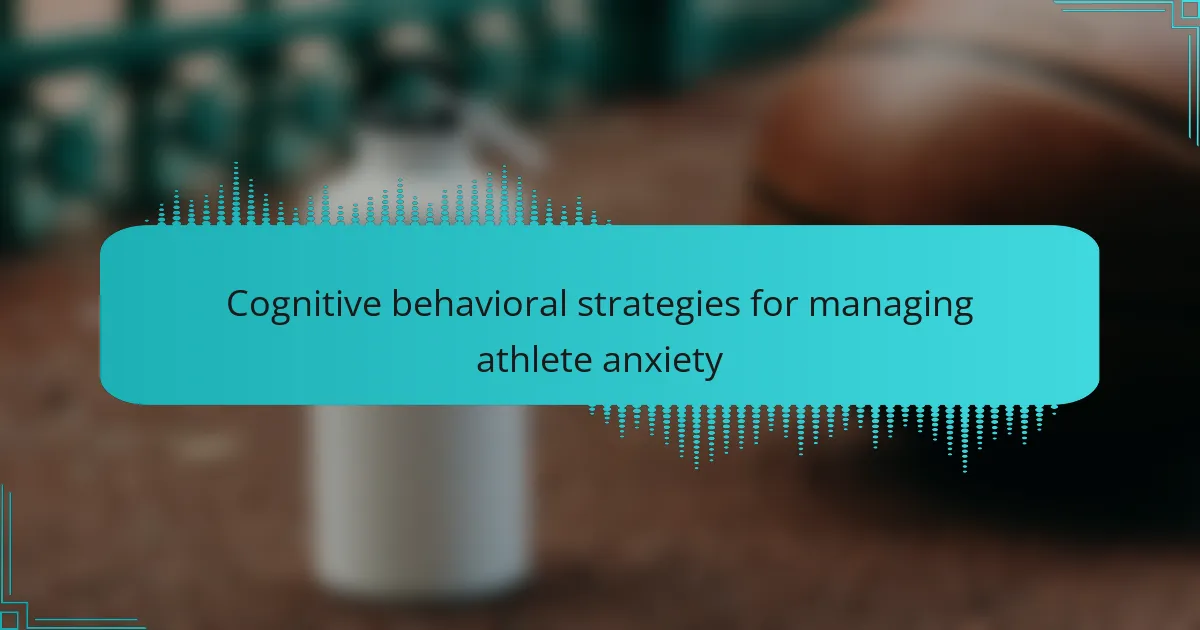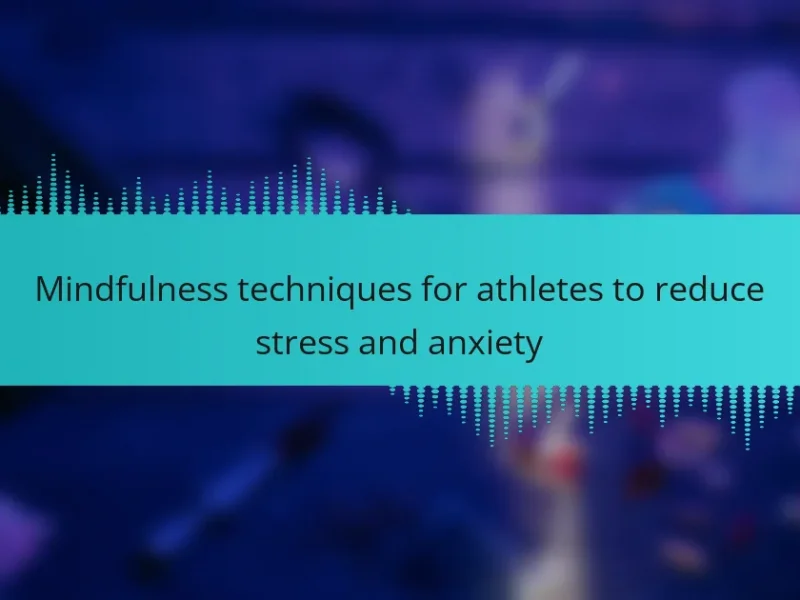Managing athlete anxiety is crucial for optimal performance. Cognitive behavioral strategies offer techniques like cognitive restructuring, exposure therapy, relaxation methods, and goal-setting. These approaches help athletes reframe negative thoughts, confront anxiety-inducing situations, and enhance focus. Understanding regional differences and avoiding common mistakes can further improve the effectiveness of these strategies.
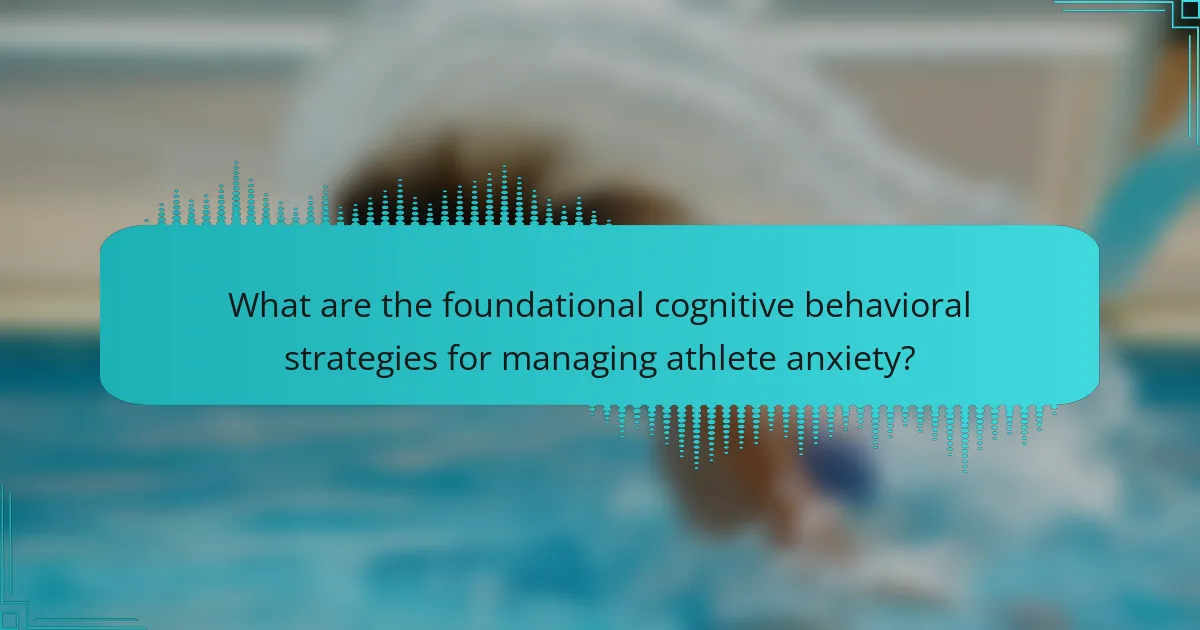
What are the foundational cognitive behavioral strategies for managing athlete anxiety?
Cognitive behavioral strategies for managing athlete anxiety include techniques that help athletes reframe negative thoughts and develop coping mechanisms. Key strategies involve cognitive restructuring, exposure therapy, relaxation techniques, and goal-setting.
Cognitive restructuring helps athletes identify and challenge irrational beliefs, replacing them with more positive and realistic thoughts. Exposure therapy gradually exposes athletes to anxiety-inducing situations, reducing their fear over time. Relaxation techniques, such as deep breathing and mindfulness, lower physiological arousal associated with anxiety. Goal-setting provides clear objectives, enhancing focus and motivation while alleviating performance pressure.
These strategies collectively empower athletes to manage anxiety effectively, promoting better performance and overall well-being.
How does cognitive restructuring help athletes cope with anxiety?
Cognitive restructuring helps athletes manage anxiety by altering negative thought patterns. This technique allows athletes to identify irrational beliefs and replace them with positive affirmations, enhancing performance under pressure. Research shows cognitive restructuring can significantly reduce anxiety levels, leading to improved focus and resilience. By fostering a growth mindset, athletes cultivate confidence and better cope with competitive stress.
What role does exposure therapy play in reducing performance anxiety?
Exposure therapy significantly reduces performance anxiety by gradually desensitizing athletes to anxiety-inducing situations. This therapeutic approach allows athletes to confront their fears in a controlled environment, fostering coping mechanisms and enhancing confidence. Research indicates that repeated exposure leads to decreased physiological and psychological responses to anxiety triggers. Consequently, athletes experience improved performance and mental resilience during competitions.
How can goal setting enhance an athlete’s mental resilience?
Goal setting enhances an athlete’s mental resilience by providing clear objectives and a structured approach to overcoming challenges. It fosters a sense of control and purpose, which can mitigate anxiety.
Setting specific, measurable goals allows athletes to track progress, reinforcing their confidence. For instance, breaking down larger goals into smaller, achievable tasks can lead to incremental successes, promoting a growth mindset. This process helps athletes develop coping strategies, making them more resilient in high-pressure situations.
Additionally, goal setting encourages reflection on performance, enabling athletes to learn from setbacks. This reflective practice can transform negative experiences into constructive feedback, further strengthening mental toughness.
Incorporating cognitive behavioral strategies, such as positive self-talk and visualization, alongside goal setting can amplify its effectiveness. These strategies help athletes reframe their thoughts, reducing anxiety and enhancing focus during competitions.
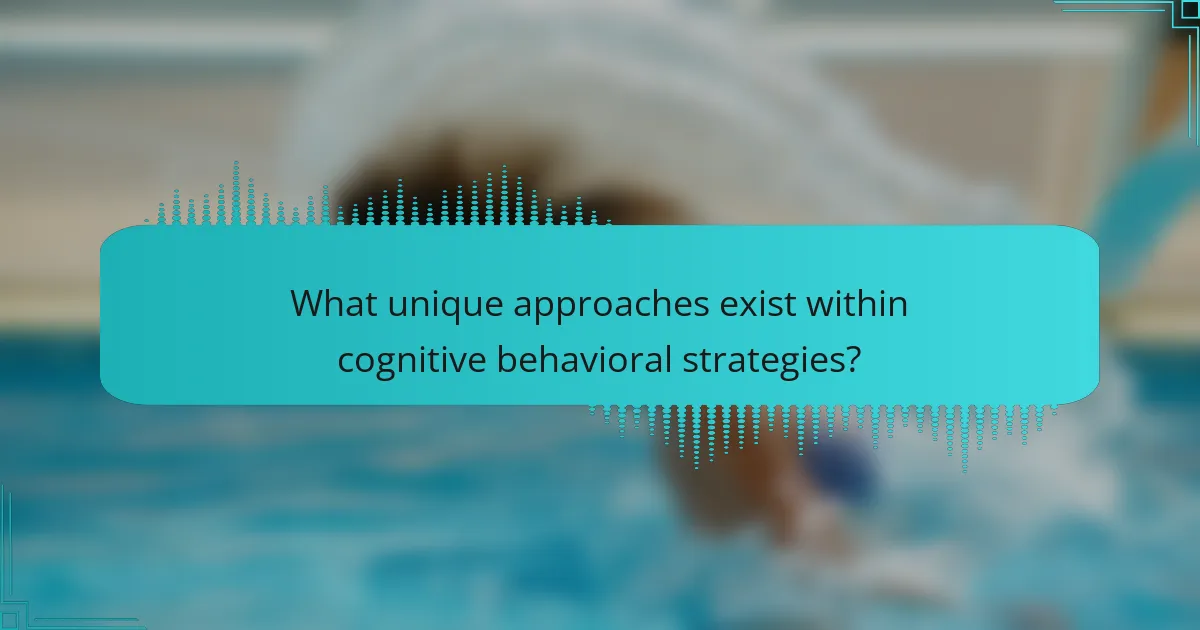
What unique approaches exist within cognitive behavioral strategies?
Cognitive behavioral strategies for managing athlete anxiety include unique approaches like exposure therapy, cognitive restructuring, mindfulness techniques, and performance visualization. These methods focus on altering negative thought patterns and enhancing coping mechanisms.
Exposure therapy gradually introduces athletes to anxiety-inducing situations, helping them build resilience. Cognitive restructuring challenges irrational beliefs, fostering a more balanced perspective. Mindfulness techniques promote present-moment awareness, reducing anxiety levels. Performance visualization allows athletes to mentally rehearse success, boosting confidence and reducing pre-competition nerves.
These unique approaches can be tailored to individual athlete needs, enhancing their mental performance and overall well-being.
How do personalized mental skills training programs differ?
Personalized mental skills training programs for managing athlete anxiety differ in their tailored approaches, focusing on individual needs. These programs may incorporate specific cognitive behavioral strategies, such as exposure therapy or cognitive restructuring, uniquely suited to the athlete’s experiences and challenges. Additionally, they often utilize varying formats, including one-on-one coaching or group sessions, to enhance engagement and effectiveness. The duration and frequency of sessions can also vary, ensuring that athletes receive the necessary support over time. Overall, personalization enhances the relevance and impact of the training, addressing unique attributes of each athlete’s anxiety.
What is the significance of visualization techniques in performance anxiety management?
Visualization techniques significantly enhance performance anxiety management by promoting mental rehearsal and positive imagery. These strategies help athletes envision successful outcomes, reducing fear and boosting confidence. Research indicates that mental imagery can decrease anxiety levels and improve focus during competition. Visualization uniquely allows athletes to practice scenarios, reinforcing skills without physical exertion. As a result, athletes often experience improved performance and reduced anxiety when they incorporate visualization into their training routines.
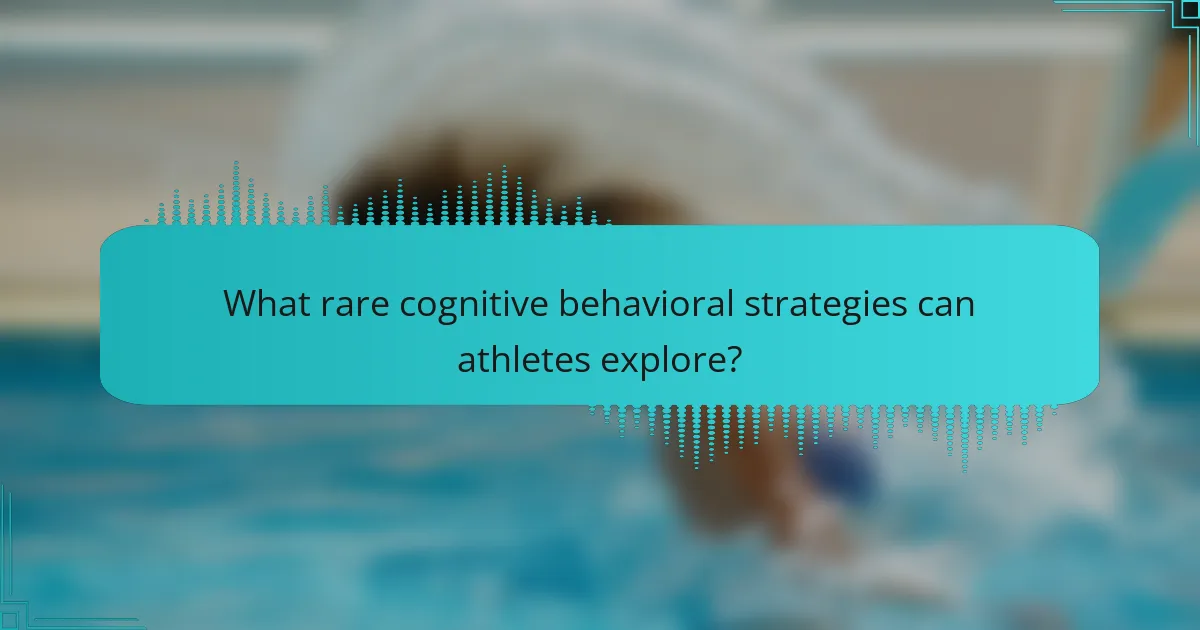
What rare cognitive behavioral strategies can athletes explore?
Athletes can explore rare cognitive behavioral strategies like exposure therapy, mindfulness-based cognitive therapy, and acceptance and commitment therapy. These strategies help athletes confront anxiety-inducing situations, enhance focus, and promote psychological flexibility. Exposure therapy gradually exposes athletes to anxiety triggers, reducing fear responses. Mindfulness-based cognitive therapy combines mindfulness practices with cognitive restructuring, improving emotional regulation. Acceptance and commitment therapy encourages athletes to accept thoughts and feelings while committing to personal values, fostering resilience.
How can athletes benefit from narrative therapy in anxiety management?
Athletes can significantly benefit from narrative therapy for managing anxiety by reframing their experiences. This therapeutic approach helps athletes articulate their stories, fostering self-awareness and emotional regulation. By exploring personal narratives, athletes can identify negative thought patterns and replace them with positive affirmations. This process enhances coping mechanisms, ultimately leading to improved performance under pressure. Research indicates that narrative therapy can reduce anxiety levels and increase resilience, making it a valuable tool in an athlete’s mental health toolkit.
What innovative strategies are being developed in cognitive behavioral therapy for athletes?
Innovative strategies in cognitive behavioral therapy for athletes focus on enhancing performance and managing anxiety. Techniques include mindfulness training, which helps athletes stay present and reduce stress. Another approach is the use of virtual reality for exposure therapy, allowing athletes to simulate high-pressure situations safely. Additionally, biofeedback is gaining traction, enabling athletes to monitor physiological responses and learn self-regulation techniques. These strategies aim to improve mental resilience and overall well-being.

How do regional differences impact the application of these strategies?
Regional differences significantly influence the effectiveness of cognitive behavioral strategies for managing athlete anxiety. Cultural attitudes towards mental health vary, impacting how athletes perceive and engage with these strategies.
For instance, in some regions, discussing anxiety openly may be encouraged, leading to a more supportive environment for implementing cognitive behavioral techniques. In contrast, areas with stigmatized views on mental health may hinder athletes from fully utilizing these strategies.
Additionally, access to mental health resources differs by region, affecting the availability of trained professionals who can guide athletes in applying cognitive behavioral strategies effectively.
Understanding these regional nuances is crucial for tailoring interventions that resonate with athletes’ cultural contexts, ultimately enhancing their performance and well-being.
What cultural factors influence athlete anxiety management in different regions?
Cultural factors significantly impact athlete anxiety management through cognitive behavioral strategies. Regional beliefs, values, and practices shape how athletes perceive and cope with anxiety. For instance, collectivist cultures may emphasize group support, while individualistic cultures may focus on personal resilience. Additionally, access to mental health resources varies by region, influencing the adoption of effective strategies. Understanding these cultural nuances can enhance anxiety management techniques tailored to specific populations.
How can athletes adapt cognitive behavioral strategies to their specific environments?
Athletes can effectively adapt cognitive behavioral strategies by tailoring techniques to their specific environments. For instance, they can implement visualization exercises that reflect their training settings, enhancing mental preparedness.
Additionally, athletes can establish routines that incorporate mindfulness practices suited to their competition venues. This approach helps manage anxiety by creating familiarity and control in high-pressure situations.
Moreover, social support systems can be integrated into cognitive strategies, utilizing teammates or coaches to reinforce positive thinking. This unique attribute fosters a sense of community, further reducing anxiety levels.
Lastly, athletes should regularly assess and modify their cognitive strategies based on performance feedback, ensuring they remain relevant and effective in changing environments.
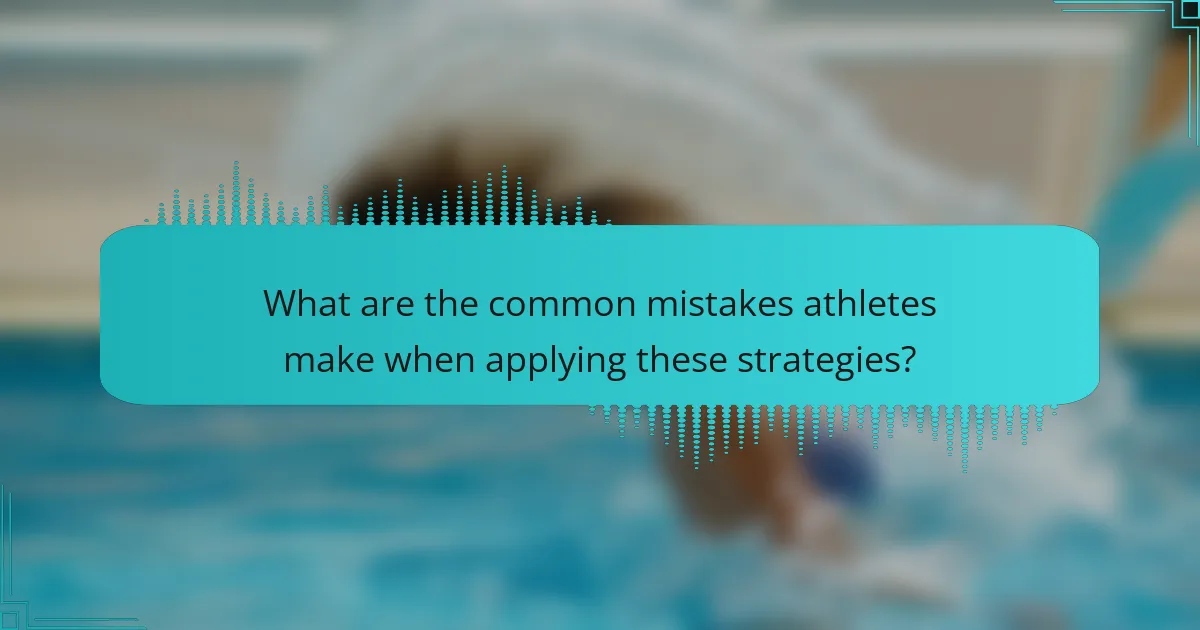
What are the common mistakes athletes make when applying these strategies?
Athletes often make mistakes such as inconsistent application of cognitive behavioral strategies, neglecting to personalize techniques, and failing to track progress. These errors can hinder anxiety management and performance. Additionally, overlooking the importance of routine practice and not seeking feedback from coaches or sports psychologists can limit effectiveness. Lastly, some athletes may underestimate the role of mental preparation in conjunction with physical training, leading to increased anxiety during competition.
What best practices should athletes follow for effective anxiety management?
Athletes can effectively manage anxiety by employing cognitive behavioral strategies. These techniques include identifying negative thought patterns, practicing mindfulness, and utilizing visualization.
Identifying negative thoughts helps athletes reframe their mindset. For instance, replacing “I will fail” with “I am prepared” can enhance confidence. Mindfulness promotes present-moment awareness, reducing anxiety about future performance. Visualization allows athletes to mentally rehearse successful outcomes, reinforcing positive expectations.
Regular practice of these strategies can lead to improved focus and performance under pressure. Implementing these cognitive behavioral techniques creates a supportive mental environment for athletes.
How can athletes optimize their cognitive behavioral strategies for performance enhancement?
Athletes can optimize cognitive behavioral strategies by integrating mindfulness, goal-setting, and visualization techniques. These methods help reduce anxiety and enhance focus during performance. Mindfulness training improves present-moment awareness, allowing athletes to manage stress effectively. Goal-setting establishes clear objectives, boosting motivation and confidence. Visualization creates mental imagery of success, reinforcing positive outcomes. Combining these strategies leads to improved emotional regulation and performance consistency.
